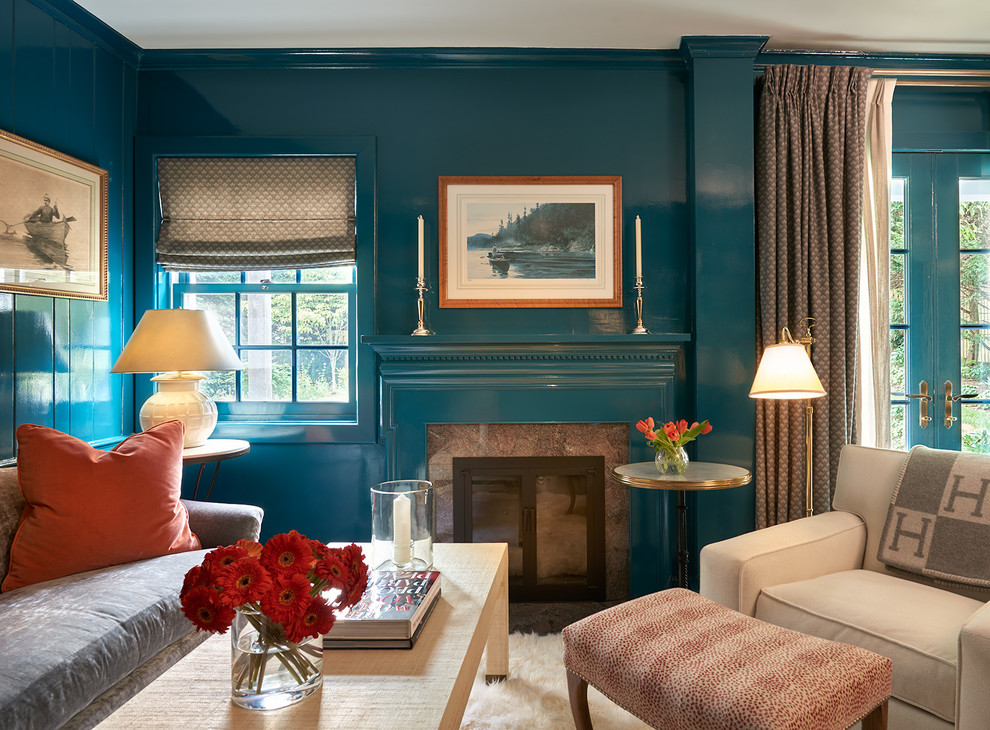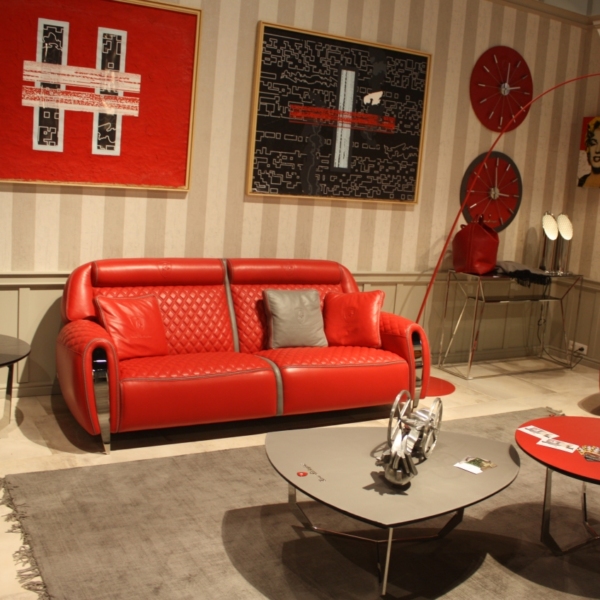Color drenching is a bold, new interior design trend that involves immersing a room entirely in the same color, encompassing the walls, trim, and sometimes the ceiling and floors. This is an innovative painting design approach that pushes traditional boundaries, resulting in a space that is harmonious, cohesive, and visually impactful. By embracing this approach, homeowners can transform their rooms into immersive environments, but this new paint style may not be right for every space or home. Before you decide to try out this new style, make sure you understand what color drenching is and where it works best.
What is Color Drenching?
Color drenching, also known as monochromatic painting or saturation painting, is a modern design technique that involves painting all surfaces with the same color. This technique creates a uniquely immersive color environment, maximizing the chosen color’s impact in the space. Color drenching can range from subtle and soothing to dramatic and bold, depending on the color you use. It allows you to infuse personality into the room while also making a dramatic statement with color.
Achieving the look you want with color drenching requires careful consideration of factors to ensure a cohesive and visually appealing result.
Here are some best practices to consider before you try this idea:
Choose the Right Color

Choosing colors is a highly personal endeavor, so when you choose a color for color drenching a space, it should be one that resonates with you and the look you want to create. Always consider the mood that a specific color will evoke; dark colors will create a moody and cozy atmosphere, whereas brighter colors will give your room a cheerful feel. When deciding on a color, consider how it will interact with the other elements in the room. Take note of elements that the color will interact with, such as natural light, ceiling height, room size, and existing decor.
Test Samples

Before you commit to a specific color, you should always test the color in different areas of your room. Experts recommend painting large pieces of poster board or other large surfaces. This way, you get a better feel for how the color looks without it competing with other colors on the wall. When you have multiple colors on large, moveable surfaces, you can move them to different areas of the room throughout the day to see how they interact with the ever-changing light in the room.
Decide Which Room Elements to Include

Knowing which elements of the room to include in the color saturation is one of the keys to creating a look you love. Painting the walls and molding one color is the standard approach. The molding or trimwork would typically include baseboards, crown molding, and door and window trim. This approach gives you more continuity by getting rid of visual “noise,” like a contrasting trim or molding color.
Another room feature to consider are the ceilings. Painting the ceilings is a bold move, but one that works well in many spaces. Painting a ceiling in a small room helps to visually expand it because it blurs the line between the ceiling and walls, but in large rooms, it can visually drop the ceiling, giving it a more intimate look.
In addition to the walls, trim, and ceilings, there are other fixed elements to consider, including built-in cabinetry, radiators, and even floors. Before you decide to paint them, consider if you want them to stand out or blend with the rest of the space. Painting everything the same will give the room a minimalist look and provide a serene canvas upon which to create your room design.
Prepare the Space

Preparing a room for painting is never as exciting as the transformative work of painting, but it is a necessary evil for a professional outcome. Begin by removing all furniture and decor from the room, or at least moving them to a location where they will not interfere with your productivity.
Drop cloths should be used to protect the flooring from paint spatters, as well as any large pieces of furniture that cannot be moved. Before you start painting, clean the surfaces and repair any wall damage, such as nail holes. Consider priming an area before painting if your surface requires it, such as porous walls that need to be primed to promote paint adhesion.
Get the Best Paint Sheen for the Surface

In color drenching, it is typical to use different paint sheens in the same color for different surfaces. This technique allows you to use the best sheen for a specific surface while still producing the color cohesion required.
For walls, it is common to use flat or matte paint. The minimal shine of this paint sheen helps to conceal any surface imperfections and provides a soft and velvety look. Trim, like baseboards and crown molding, and cabinetry require semi-gloss or satin paint. These paints provide a subtle shine that highlights the architectural details and makes these surfaces easier to clean. The choice of a sheen for ceilings depends on personal preference and the desired outcome. Many people opt for flat or matte ceilings to minimize glare and make them cohesive with the walls. Other people choose a satin or eggshell finish to give the ceiling a subtle, reflective quality.
In certain rooms, like bathrooms or kitchens, where there is more moisture and humidity, some homeowners may choose to use specific paint formulations or semi-gloss paints on the walls to help make them more durable.
Create Some Contrast

Adding some contrasting elements and textures to a color-drenched room is essential to keeping it from feeling monotonous and lacking depth. Incorporating contrasting textures using furniture and decor elements such as rugs, artwork, and textiles helps to highlight the room’s distinct style. Choose contrasting colors to balance the dominant hue and add depth and visual interest. Contrasting colors can also be used to highlight specific architectural features in a room, such as a fireplace or a built-in cabinet.
Rather than using contrasting colors, some designers give the room more dimension by using contrasting textures. Incorporate a variety of consistency to create tactile interest and dimension in the room. Mix smooth and rough surfaces, such as polished wood furniture, against a matte wall or soft wool rug. You can also use patterns and prints to help layer the texture and color of the room. Create visual excitement by incorporating prints into wallpaper, curtains, upholstery, and other decorative elements.
Which Rooms Work Best for Color Drenching?
Color drenching works in almost any room where you apply the technique. Many people choose to use this technique in large public spaces such as living rooms and dining rooms, while others prefer to apply it in private rooms such as bedrooms, where the color can be used to create a serene and intimate atmosphere. Whatever room you choose, it is best to apply it in rooms with natural closures such as doorways or trimwork that separates them; otherwise, you will have a difficult time creating a barrier to prevent the color from flowing into the next room.
Color drenching can be a bold and effective design choice for creating visually impactful and cohesive interiors, but careful consideration of the pros and cons will help you decide whether it is the best option for you.
Pros:
- Unified Look: Color drencing provides an easy way to give a room a cohesive and harmonious atmosphere by unifying all the room elements with the same color. This can produce a striking and sophisticated aesthetic.
- Enhanced Ambience: Color drenching elevates the mood or atmosphere you want to create in a room, whether it is dark and moody or light and cheerful.
- Modern and Bold: Color drenching is a modern design trend that gives interior spaces a new and refreshing look. It has the potential to make a strong impact while also highlighting the homeowner’s design preferences.
- Visual Impact: Painting all surfaces in the same color can help to create a sense of expansiveness or intimacy, depending on the color chosen.
- Versatility: Color drenching can be used in a variety of settings, including commercial and residential. It can also be used for a variety of design styles and color schemes.
Cons:
- Limited Flexibility: Once a room is color drenched, it can be difficult to change as it involves painting so many surfaces and intricate trimwork. This is a disadvantage for those who like to change their color schemes frequently.
- Risk of Overwhelming a Room: Color drenching can sometimes make a space feel closed and claustrophobic, depending on the colour you choose. A careful consideration of the color and the space can help to avoid this issue.
- Lack of Visual Interest: Without contrasting elements in the room, whether with color, texture, or pattern, color drenching can make a room feel flat and monotonous. The incorporation of various elements in decor or furniture can help alleviate this problem.
- Trendy Design Style: Some people may object to color drenching because they believe it is a trendy style that will fade quickly. Color drenching is a popular design trend, but painting trim with bold and vibrant colors has been around for a long time. While color drenching is relatively recent, it is a style with historic roots.


